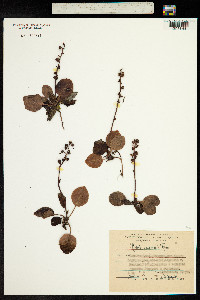Pyrola asarifolia
|
|
|
|
Family: Ericaceae
Pink Wintergreen, more...alpine shinleaf, liverleaf wintergreen
|
Plants rhizomatous, (0.8-)1.5-4.3(-6.4) dm. Leaves: petiole (6-)15-65(-109) mm, channeled adaxially, glabrous; blade not maculate, dull and light green to purplish abaxially, shiny and dark green adaxially, ovate, elliptic, round, or reniform, (10-)24-71(-98) × (10-)13-49(-83) mm, coriaceous, base cordate or rounded to decurrent, margins entire or crenulate or denticulate, apex obtuse to acute. Inflorescences 1 per stem, 4-29-flowered; peduncular bracts 1-3(-5), ovate to oblong-ovate, 7-16 × 2.5-5 mm, chartaceous or membranous, margins entire; inflorescence bracts ovate to oblong-ovate, usually as long as or longer than, sometimes shorter than subtended pedicels, 3-17 × 1-3.6 mm, chartaceous. Pedicels (3-)4-11 mm. Flowers: calyx lobes appressed or spreading in fruit, green or pinkish with margins hyaline to white or pinkish, triangular to triangular-ovate, 1.4-5.5(-5.8) × 1.3-2.7 mm, margins entire or erose-denticulate, apices acute to acuminate; petals white, white proximally and pinkish distally, or pink to purplish red throughout, obovate to round, 4.8-9.1 × 2.9-6 mm, margins entire; stamens 4.5-7.5 mm; filament base 0.6-1.1 mm wide; anthers (1.7-)2-3.5 (-3.9) mm, apiculations 0.1-0.5(-0.7) mm, thecae creamy white or tan to dark pink, tubules pink to dark pink, 0.1-0.4 mm, gradually narrowed from thecae, lateral walls touching for most of their lengths, pores 0.1-0.2 × 0.05-0.1 mm; ovary smooth; style exserted, 7-10 mm; stigma 0.7-1.6 mm wide, lobes erect, (without subtending ring of hairs). Capsules depressed-globose, 4-5 × 6-8 mm. 2n = 46. Regional variation in Pyrola asarifolia in North America was examined by E. Haber (1983) using morphological and flavonoid data. Despite finding some longitudinal geographic differentiation, he concluded that most earlier-recognized segregates of the P. asarifolia complex were best included within a single, polymorphic species, with the large-bracted, denticulate-leaved, Pacific Northwest and northern Rocky Mountains element (subsp. bracteata) distinguishable from the relatively short-bracted, crenate-leaved, transcontinental element (subsp. asarifolia). Included within his concept of the latter subspecies were Asian plants referred to P. incarnata (de Candolle) Freyn. A more comprehensive study of the Asian element (Haber and Hiroshi Takahashi 1988) led to the conclusion that this vicariad was sufficiently distinct to warrant recognition as P. asarifolia subsp. incarnata (de Candolle) Haber & Hir. Takahashi; it is distinguished from the North American subspecies by its narrower sepals. Takahashi (1993) found differences also in the seeds of the two subspecies.
Lvs mostly 3-6 cm; scapes 1.5-3 dm, with usually 1-3 scale-lvs; sep triangular, 2-3 mm, acute, entire, widest just above the base and therefore slightly overlapping; pet 5-7 mm, pink to pale purple; anthers cuspidate at base, abruptly narrowed above into very short tubes; style declined. Moist woods and bogs; Nf. to Alas., s. to N.Y., n. Ind., Minn. and N.M. July, Aug. (P. uliginosa) Gleason, Henry A. & Cronquist, Arthur J. 1991. Manual of vascular plants of northeastern United States and adjacent Canada. lxxv + 910 pp. ©The New York Botanical Garden. All rights reserved. Used by permission. |









































































